Preoperative risk factors associated with peri-operative psychiatric diagnosis in oral cancer patients
Arnab Mukherjee1, Chitralekha Bhowmick1, Shreshta Chattopadhyay1, Mohamed Abdul Kathar2, Moitri Bhattacharyya1, Shazia Nasreen1, Prateek Jain2, Pattatheyil Arun2 and Soumitra Shankar Datta1,3
1Department of Palliative Care and Psycho-Oncology, Tata Medical Centre, New Town, Rajarhat, Kolkata 700160, India
2Department of Head and Neck Surgery, Tata Medical Centre, New Town, Rajarhat, Kolkata 700160, India
3MRC Clinical Trials Unit, Institute of Clinical Trials and Methodology, University College London, London WC1V 6LJ, UK
a https://orcid.org/0000-0002-6325-7116
b https://orcid.org/0000-0002-9599-5068
c https://orcid.org/0000-0003-4363-0910
d https://orcid.org/0000-0002-8894-2670
e https://orcid.org/0000-0002-9829-8583
f https://orcid.org/0000-0003-1674-5093
Abstract
Background: Head and neck cancers (HNCs) are one of the commonest cancers in low- and middle-income countries. There is a paucity of data on comorbid psychiatric problems associated with HNCs. The present study is aimed at reporting the pattern of psychiatric caseness in HNC patients who were referred to specialist psycho-oncology service and also investigate the predictors of psychiatric caseness in oral cancer patients.
Methods: Case records of all patients with HNC referred to an integrated psycho-oncology service over 7 years (October 2011–December 2018) from a cancer hospital were analysed. All patients were assessed by a trained consultant psychiatrist and ICD-10 diagnoses were ascertained based on a clinical interview with the patients and family members. Associations of psychiatric caseness for consecutive oral cancer patients assessed by the psycho-oncology services over 2 years (January 2017–December 2018) were calculated by using univariate and multivariate statistical methods. Simple descriptive statistics of the referred patients were conducted, followed by logistic regression to find the associations of psychiatric caseness in oral cancer patients.
Results: The psycho-oncology service assessed 771 HNC patients over 7 years. The commonest referrals were patients with oral cancer (75%, 558/771). For the years 2017–2018, 179 consecutive oral cancer patients were evaluated by the psycho-oncology service. Multivariate logistic regression analysis showed that being a woman (OR = 2.33; 95% CI = 1.02–5.32; p = 0.04); having worries about having pain in the post-operative period (OR = 2.55; 95% CI = 1.2–5.38; p = 0.01); worries about implications of the cancer and its treatment on the family (OR = 3.5; 95% CI = 1.19–10.57; p = 0.02); and longer duration of hospital stay period (OR = 1.08; 95% CI = 1.003–1.16; p = 0.04) were independently associated with psychiatric caseness even after controlling for confounders.
Discussion: Specialist psycho-oncology services are important in the management of oral cancer patients and in addressing the mental health needs of this very vulnerable group of patients. A combination of psychoeducation, pragmatic psychological interventions and medications were used to treat these patients.
Keywords: head and neck cancers, India, psychiatry, psycho-oncology, oral cancer
Correspondence to: Soumitra Shankar Datta
Email: ssdatta2000@yahoo.com
Published: 26/05/2022
Received: 30/09/2021
Publication costs for this article were supported by ecancer (UK Charity number 1176307).
Copyright: © the authors; licensee ecancermedicalscience. This is an Open Access article distributed under the terms of the Creative Commons Attribution License (http://creativecommons.org/licenses/by/4.0), which permits unrestricted use, distribution, and reproduction in any medium, provided the original work is properly cited.
Background
In 2020, the Global Cancer Observatory database estimated that cancers of the head and neck region constitute the second most common cancers in India [1]. It has been estimated that head and neck cancers (HNCs) constitute 25%–30% of all cancers in India [2]. In 2020 alone, there were 135,929 new patients diagnosed with oral cancer, 34,687 patients diagnosed with cancer of the larynx and 28,489 newly diagnosed patients with cancer of the hypopharynx in India [1]. Over the years, there has been an increase in awareness about cancer, along with an increase in detection rates and better outcomes of cancers, including HNCs, in different part of the world, including India [3, 4]. However, even with these advances and refinement of treatment modalities of HNCs, psychological morbidities continue to be common in these patients. Pre-existing psychiatric illness or vulnerability, the fear associated with receiving a cancer diagnosis, the need to undergo painful interventions, resultant deformities causing body image problems and financial concerns increase the risk of psychiatric disorders in HNCs [5–8].
Head and neck surgeries interfere with the motor functions, like speech, chewing and swallowing; sensory functions, like taste and smell; and social functions, like communication and expression of interest. As disfigurement due to HNC surgeries is often visible, HNCs are known to be associated with poor self-esteem, poorer self-confidence and body image difficulties when compared to less visible cancers [9]. Younger patients are more worried about disfigurement [10, 11]. Women, especially those with poor social support, have been found to be affected more often when they undergo disfiguring HNC surgeries [11]. HNC survivors with disfigurement also encounter adverse economic and social consequences and are commonly stigmatised, and research has shown that these effects persisted even after 1 year of surgery [12]. Nearly 40% of the patients reported concerns about their appearance long after the surgery [10]. Studies have shown that cosmetic rehabilitation improved patient satisfaction over time when compared with their baseline score, but this is often not a priority and referrals are infrequent to address cosmesis and appearance-related issues [13, 14]. The perceived social consequences of change in appearance is associated with higher body image concerns [15].
HNC is associated with the higher prevalence of psychological distress, even 7–11 years after treatment [16, 17]. Many of these patients did not receive psychological intervention and the focus on tumour control often takes priority in low- and middle-income countries (LMICs). HNC patients and doctors often perceive depressive and anxiety symptoms as natural responses to cancer and, as a result, patients with psychological symptoms may not report these symptoms to their oncologists, leading to both under-reporting and under-diagnosis [17]. Factors that tend to precipitate psychological distress in patients are pain and other physical symptoms, social stressors, premorbid personality factors, prognostic factors, treatment-related side effects, past history of psychiatric morbidity and treatment [18]. Studies have shown that anxiety is more common at the time of biopsy or prior to surgery [19], and people feel more depressed during the post-operative period [9]. The usual responses are worries, fear, sense of helplessness, anguish and demoralisation [6, 20]. The prevalence of depression varies across studies [19]. Studies have shown a prevalence of depression over the complete course of HNC treatment, from the time of evaluation through to recovery or palliation [21]. The severity of physical symptoms and resultant dysfunctionality, lack of emotional and social support and coping styles of individual patients were associated with increased rates of depression in HNC patients [21]. One study reported that as low as 14% of HNC patients with depression were identified and treated appropriately [18].
The aim of the present study was to report real-life data on psychiatric morbidities of HNC patients based on a 7-year long experience of providing psycho-oncology services to HNC patients in a tertiary cancer centre. The current practice in the study centre is to conduct preoperative psychiatric assessment for patients planned for HNC surgeries. The goal of this assessment is to prepare the patients for the upcoming surgery and to address their concerns so that they are less apprehensive and can cope with the treatment process better. Previous research has reported that two-thirds of the patients have reported in studies that preoperative counselling has been helpful [22, 23]. Preoperative psychiatric evaluation could also identify people at risk of post-operative psychiatric morbidities.
The scope and need of psycho-oncology services have also grown exponentially. This study examines the peri-operative psychiatric morbidities of HNC patients with a special emphasis on oral cancer from a specialist cancer centre in eastern India. Recent research on the journey of cancer patients from India has elicited complexities in the access to cancer care, emphasised the psychological journey of patients, highlighted stigma of being a cancer patient, impact of decision-making on adherence to treatment and the economic impact of cancer care alongside the modifiers to accessing cancer care [24].
Methods
Objectives
The first objective of the present study was to explore and describe the pattern of psychiatric morbidities in HNC patients in a specialist cancer centre. The second objective was to study the associations of psychiatric morbidities in the peri-operative period for oral cancer.
Setting
The study was conducted in a not-for-profit cancer centre in eastern India, Tata Medical Center, Kolkata, which currently has 450 beds and state-of-the-art cancer treatment facilities. The hospital caters mainly to patients from the East Indian states of West Bengal, Jharkhand, Bihar, Assam, Sikkim, Meghalaya, Mizoram and neighbouring countries, like Bangladesh, Nepal and Bhutan. The hospital has a psycho-oncology service, established in the very first year of its inception, led by consultant psychiatrists and psychologists. The psycho-oncology department has daily out-patient services and in-patient services, both led by the two consultant psychiatrists. Most patients referred to psycho-oncology are seen on the same day of referral.
Psycho-oncology assessment protocol for HNC patients
HNC patients were frequently referred to the department of psycho-oncology as an out-patient prior to surgery and again in the post-operative period. Patients were assessed on the same day of referral as per the existing protocol by one of the consultant psychiatrists of the department. The department of psychology, since its inception in 2011, has had a paperless documentation practice. All clinical notes were contemporaneously recorded in the electronic health records. At the end of 2016, there was a change made for the shared care protocol for patients with oral cancer as this was the commonest HNC needing psychiatric inputs. Since January 2017, all patients with oral cancers were prospectively evaluated by one of the two consultant psychiatrists during the preoperative period. Alongside a standard psychiatric assessment, the preoperative oral cancer patients were screened for the four most common psychological worries: a) worries related to the possibility of experiencing pain in the post-operative period; b) worries related to future body image problems secondary to facial disfigurement; c) worries related to direct and indirect costs of cancer care impacting finances of the family; and d) worries related to the cancer treatment disrupting family life. The psychiatric diagnosis reported in this study had taken into consideration both the preoperative psychiatric assessment and the post-operative assessment. The oral cancer patients were also referred to the psycho-oncology service in the immediate post-operative period for continuity of psychiatric care and for providing psychological support as and when appropriate. A separate contemporaneous database for oral cancer patients was started to aid in better clinical communication that was maintained by the clinical psycho-oncology fellows of the department.
Data collection
Data for all HNC patients who had been evaluated by the department of psycho-oncology between 2011 and 2018 were examined for the purposes of this study. The records included the basic demographic details of the patient, the type and stage of cancer, medical comorbidities of the patient, type of surgery undertaken, details of the psychiatric assessment by a consultant psychiatrist, psychiatric diagnosis, if any, for the patient and the nature of interventions undertaken by the psycho-oncology service. Additionally, for the years 2017–2018, data for all oral cancer patients were maintained in the psycho-oncology departmental database. Data were entered on a predetermined proforma. In view of the retrospective nature of the study, waiver of consent was obtained from the institutional ethics committee as per institutional policy (IEC Protocol Waiver No – EC/WV/TMC/012/19).
Data analysis
The data were analysed using Statistical Package for the Social Sciences 25. Univariate analysis included chi-squared test for categorical variables and t-test for continuous variables. Multivariate logistic regression analysis was carried out for patients with oral cancer, using the dichotomous variable of psychiatric caseness as the intendant variable and other variables as predictor variables that were significant in univariate analysis.
Results
Over the period of the study, the Department of Psycho-oncology had evaluated 771 HNC patients (Table 1). Majority of them were men (72%, 555/771) and had been diagnosed to have oral cancers (75%, 558/771) that included cancer of the tongue, buccal mucosa, alveolus, lip, retromolar trigone, floor of mouth and hard palate. Of these patients, primary closure was carried out for 26.6% (205/771) and reconstruction for 59.1% (456/771). 14.3% of the patients seen by psycho-oncology and HNC service were inoperable as they presented with late stages. Tracheostomy was performed in 44.1% of the patients (240/771) and it was not needed in 55.9% of the patients (431/771). Psychiatric diagnoses were based on the assessments made: immediate preoperative psychiatric assessment and immediate post-operative psychiatric assessment. All patients were assessed by one of the two consultant psychiatrists with special expertise in psycho-oncology. Over the years, around one-third of the patients assessed by the psycho-oncology service were found to have no psychiatric diagnosis.
Table 1. Characteristics of HNC patients seen by psycho-oncology services from 2011 to 2018.
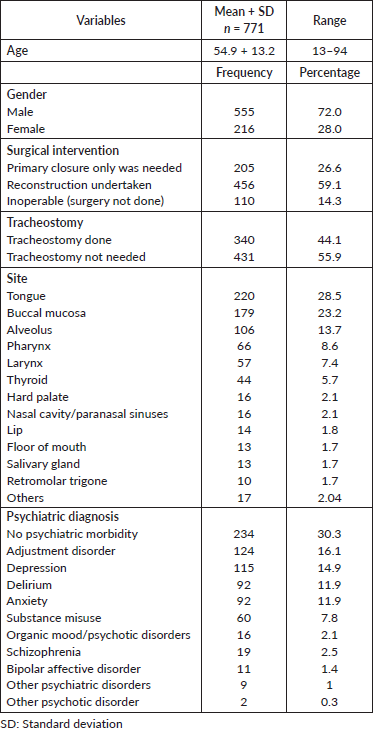
Since 2017–2018, all patients with oral cancer were assessed preoperatively by one of the consultant psychiatrists who led the psycho- oncology service. The commonest cancers within the oral cavity (Table 2) included tongue cancer (41.3%, 74/179) and cancer of the buccal mucosa (31.8%, 57/179). More than half (53%, 95/179) of the patients with oral cancer had qualified for a psychiatric diagnosis. The commonest psychiatric comorbidities (Table 3) for peri-operative oral cancer patients were anxiety disorders (26.3%, 47/179), adjustment disorders (12.8%, 23/179) and depression (6.1%, 11/179). Univariate analysis showed that the following factors were predictive of peri-operative psychiatric diagnosis: being a woman, having worries about experiencing pain in the post-operative period, having worries regarding body image in the post-operative period and worries about the negative impact of the treatment on the family (Table 4). Several other factors, such as distance travelled from home to the hospital, age of the patient, occupation of the patient, stage of the disease and presence of tracheostomy tube, were not associated with increased psychopathology in HNC patients. Multivariate logistic regression analysis (Table 5) showed that being a woman (OR = 2.33; 95% CI = 1.02–5.32; p = 0.04); having worries about experiencing pain in the post-operative period (OR = 2.55; 95% CI = 1.2–5.38; p = 0.01); worries about implications of the cancer and its treatment on the family (OR = 3.5; 95% CI = 1.19–10.57; p = 0.02); and longer duration of hospital stay (OR = 1.08; 95% CI = 1.003–1.16; p = 0.04) were independently associated with psychiatric caseness even after controlling for confounders. Surprisingly, worries about potential body image and deformity was not associated with psychiatric caseness.
Discussion
Surgeries for oral cancer are often associated with significant disfigurement, physical and emotional pain and resultant emotional distress. The present study on psychiatric morbidity in patients with oral cancer showed that being a woman, having preoperative worries about pain, having preoperative worries about impact of the cancer treatment on the family and longer duration of hospital stay were independently associated with psychiatric diagnosis in the peri-operative period. The strengths of the present study include a relatively large sample size, evaluation being conducted by a trained consultant psychiatrist with special interest in psycho-oncology and the study being set in the LMIC that contributes the greatest number of HNC patients globally. Having a dedicated psycho-oncology service working closely with HNC services and having a standardised preoperative psychiatric evaluation protocol for HNC patients made the assessments uniform. The weaknesses of the study were a) the cross-sectional nature of the study and b) being conducted in a single centre.
The present study on oral cancer patients showed that being a woman was associated with psychiatric morbidity. This follows a similar trend around the world [25, 26] and is in line with the findings of increased mood disorders in women around the world [27]. There may be additional social factors that make women with cancer more vulnerable in LMICs based on the existing gender gap [28] and inequality in access to care [29, 30]. Many patients expressed significant worries about the implications of their illness and treatment on their family. Our study showed that preoperative worrying of patients about their family was associated with a psychiatric diagnosis. They were often anxious that their illness and treatment would impact the job of their caregivers, the education of their children and the overall financial security of the family. Previous research from the same centre showed that patients had worries related to the impact of the cancer on them and their families due to the requirement of family members staying back from work due to the diagnosis of cancer; occasional inability of family members to continue with their education; and being stigmatised due to their diagnosis in their day-to-day lives [24]. Most of the cancer care in India is funded by the patient and their families and researchers have highlighted the lack of infrastructure, paucity of trained resources and escalated costs of cancer care in India [31].
Table 2. Characteristics of patients with oral cancer evaluated prospectively by psycho-oncology services in 2017–2018 .
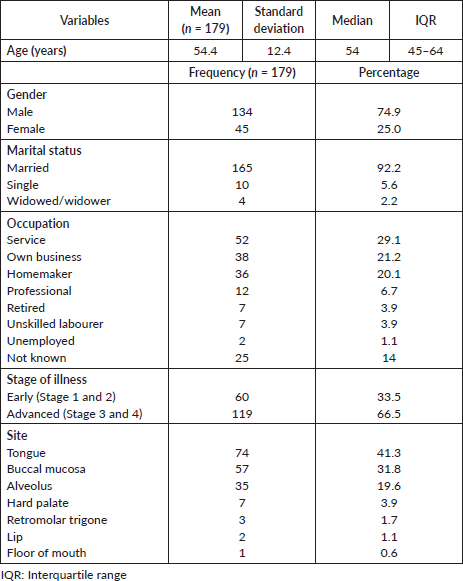
Table 3. Peri-operative psychiatric diagnosis of patients with oral cancer.
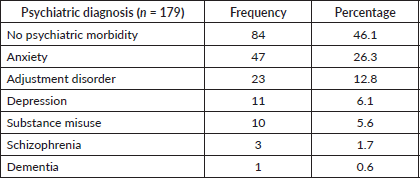
Table 4. Univariate analysis: associations with psychiatric diagnosis as diagnosed by ICD-10 in peri-operative HNC patients.
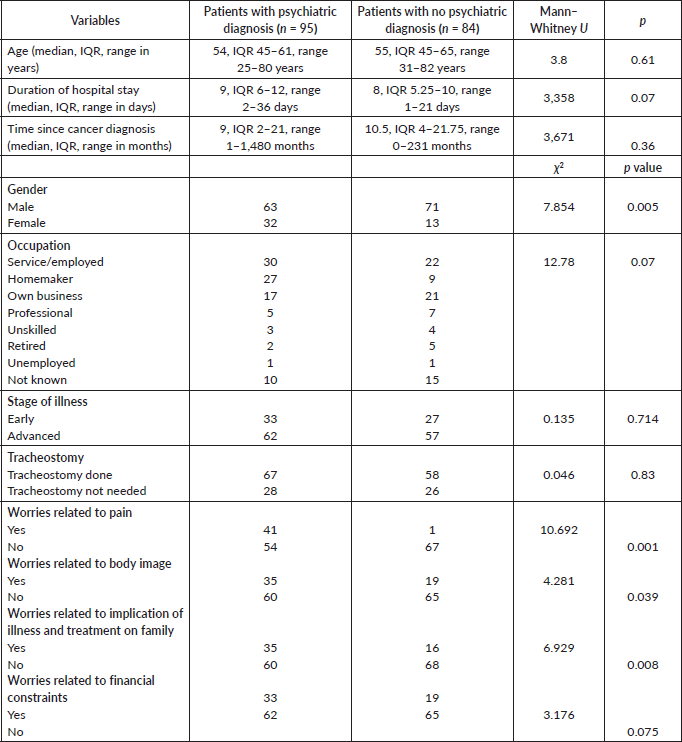
Table 5. Multivariate analysis: associations of psychiatric caseness in oral cancer patients in the peri-operative period.

Body image is a subjective perception about one’s own appearance, and is often modified by the reactions elicited from others [32]. People with oral cancers often experience body image disturbance secondary to disfigurement related to surgery. Earlier research on preoperative evaluations showed more than three-quarter of the people with oral cancers have concerns about their body image [33]. Body image disturbances are known to lead to self-stigma, social isolation, difficulty in reintegrating into previous job, intimacy with partner and psychological morbidities [12]. However, a surprising finding in our study was that perceived worries about potential body image problems were not associated with more psychiatric problems. This could be due to the fact that we studied the patients in the immediate pre- and post-operative periods, and the problems of body image may evolve over time and require long-term follow-up. Pain and physical symptoms remain important predictors for depression [34] and are associated with psychological morbidities in oral cancer patients. Earlier research has shown that presurgical anxiety about pain remains an important predictor for post-surgical intensity of pain and psychological morbidity [34–36]. Experiencing physical pain even after completion of treatment was found to be associated with depressive and anxiety symptoms in previous studies [37].
Our study found longer hospital stay was associated with increased psychiatric problems as reported by studies from other parts of the world [38]. Prolonged admission in the post-operative phase is almost always due to multiple medical morbidities and more intense monitoring of medical parameters. Earlier work on patients with oral cancer from the UK had shown that patients were psychologically relieved when the monitoring was stepped down from hourly to 4 hours [39]. The association of psychiatric diagnosis with longer duration of admission is thus not surprising.
The role of psycho-oncology services is extremely valuable in HNCs. Preoperative evaluation of anxiety and common worries, preparedness for treatment, social stressors, personality factors, coping resources and pre-existing psychiatric morbidities can help the treating team to assess the presence of or anticipate risk of psychological morbidity in a patient. It can provide valuable clinical information about the patient’s coping ability. Unaddressed psychiatric morbidities may interfere with the ability of the patient to engage with oncology services. This study reports the findings of the preoperative psychiatric evaluation for people with oral cancers. The common interventions undertaken by the psycho-oncology service included a mental health assessment of the patient in the context of the medical condition, planning appropriate psychiatric care and coordinating with the surgical service and the intensive care unit. The profile of a typical HNC patient who qualifies for various psychiatric diagnoses, reasons for referrals, goals of mental health care in the peri-operative period and interventions offered are summarised for the reader in Table 6. The value of timely interventions cannot be over emphasised.
Conclusion
HNCs are one of the commonest cancers in LMICs and require multidisciplinary care. Psychiatric comorbidities are common and are best managed when referred to a specialist psycho-oncology service early on. The various mental health conditions may require specialist mental health inputs and are best managed jointly with HNC surgical oncologists. There is very little systematic data on this group from LMICs and further research is required in the future.
Table 6. The prototypes of patients with HNCs jointly managed by psycho-oncology services.
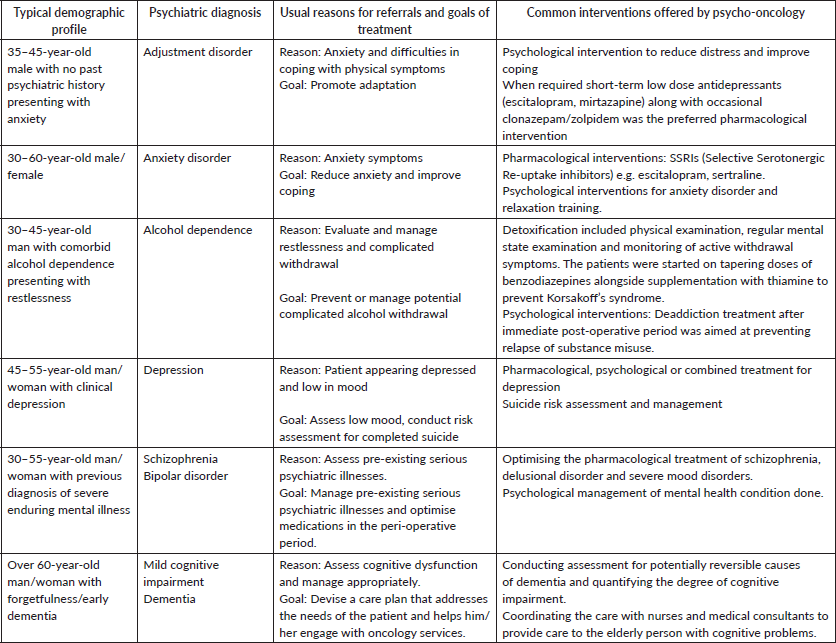
Acknowledgments
Part of this work was presented in the award paper session of the TMC, Kolkata-ecancer Oncology Summit 2021 by CB who was the winner of the Umberto Veronesi best presentation prize for research in HNC cancer (First Prize).
Conflicts of interest
The authors declare that they do not have any conflicts of interest.
Funding
The work was not supported by any external funding.
References
1. World Health Organisation (2020) Cancer today: data visualization tools for exploring the global cancer burden in 2020 [Internet] [https://gco.iarc.fr/] Date accessed: 07/09/21
2. Dandekar M, Tuljapurkar V, and Dhar H, et al (2017) Head and neck cancers in India J Surg Oncol 115(5) 555–563 https://doi.org/10.1002/jso.24545 PMID: 28120407
3. Miller KD, Siegel RL, and Lin CC, et al (2016) Cancer treatment and survivorship statistics, 2016 CA Cancer J Clin 66(4) 271–289 https://doi.org/10.3322/caac.21349 PMID: 27253694
4. Pulte D and Brenner H (2010) Changes in survival in head and neck cancers in the late 20th and early 21st century: a period analysis Oncologist 15(9) 994–1001 https://doi.org/10.1634/theoncologist.2009-0289 PMID: 20798198 PMCID: 3228039
5. Nguyen N-TA and Ringash J (2018) Head and neck cancer survivorship care: a review of the current guidelines and remaining unmet needs Curr Treat Options Oncol 19(8) 44 https://doi.org/10.1007/s11864-018-0554-9 PMID: 29987676
6. Cohen EEW, LaMonte SJ, and Erb NL, et al (2016) American Cancer Society head and neck cancer survivorship care guideline CA Cancer J Clin 66(3) 203–239 https://doi.org/10.3322/caac.21343 PMID: 27002678
7. Alexander PJ, Dinesh N, and Vidyasagar MS (1993) Psychiatric morbidity among cancer patients and its relationship with awareness of illness and expectations about treatment outcome Acta Oncol 32(6) 623–626 https://doi.org/10.3109/02841869309092441 PMID: 8260179
8. Dinker NL, Kumar P, and Naidu S (2019) Psychiatric morbidity in cancer patients Int J Contemp Med Res IJCMR [Internet] 6(6) [https://www.ijcmr.com/uploads/7/7/4/6/77464738/ijcmr_2533_v1.pdf] Date accessed: 08/12/20
9. Mochizuki Y, Matsushima E, and Omura K (2009) Perioperative assessment of psychological state and quality of life of head and neck cancer patients undergoing surgery Int J Oral Maxillofac Surg 38(2) 151–159 https://doi.org/10.1016/j.ijom.2008.11.007 PMID: 19135867
10. Katre C, Johnson IA, and Humphris GM, et al (2008) Assessment of problems with appearance, following surgery for oral and oro-pharyngeal cancer using the University of Washington appearance domain and the Derriford appearance scale Oral Oncol 44(10) 927–934 https://doi.org/10.1016/j.oraloncology.2007.12.006 PMID: 18329949
11. Katz MR, Irish JC, and Devins GM, et al (2003) Psychosocial adjustment in head and neck cancer: the impact of disfigurement, gender and social support Head Neck 25(2) 103–112 https://doi.org/10.1002/hed.10174 PMID: 12509792
12. Rhoten BA, Murphy B, and Ridner SH (2013) Body image in patients with head and neck cancer: a review of the literature Oral Oncol 49(8) 753–760 https://doi.org/10.1016/j.oraloncology.2013.04.005 PMID: 23683468
13. Huang S and Liu H-E (2008) Effectiveness of cosmetic rehabilitation on the body image of oral cancer patients in Taiwan Support Care Cancer Off J Multinatl Assoc Support Care Cancer 16(9) 981–986
14. Millsopp L, Brandom L, and Humphris G, et al (2006) Facial appearance after operations for oral and oropharyngeal cancer: a comparison of casenotes and patient-completed questionnaire Br J Oral Maxillofac Surg 44(5) 358–363 https://doi.org/10.1016/j.bjoms.2005.07.017
15. Teo I, Fronczyk KM, and Guindani M, et al (2016) Salient body image concerns of patients with cancer undergoing head and neck reconstruction Head Neck 38(7) 1035–1042 https://doi.org/10.1002/hed.24415 PMID: 26970013
16. Singer S, Krauß O, and Keszte J, et al (2012) Predictors of emotional distress in patients with head and neck cancer Head Neck 34(2) 180–187 https://doi.org/10.1002/hed.21702
17. Bjordal K and Kaasa S (1995) Psychological distress in head and neck cancer patients 7-11 years after curative treatment Br J Cancer 71(3) 592–597 https://doi.org/10.1038/bjc.1995.115 PMID: 7880743 PMCID: 2033644
18. Frampton M (2001) Psychological distress in patients with head and neck cancer: review Br J Oral Maxillofac Surg 39(1) 1–4 https://doi.org/10.1054/bjom.2000.0547
19. De Boer MF, Mccormick LK, and Pruyn JFA, et al (1999) Physical and psychosocial correlates of head and neck cancer: a review of the literature Otolaryngol Neck Surg 120(3) 427–436 https://doi.org/10.1016/S0194-5998(99)70287-1
20. Alias A and Henry M (2018) Psychosocial effects of head and neck cancer Oral Maxillofac Surg Clin North Am 30(4) 499–512 https://doi.org/10.1016/j.coms.2018.06.010 PMID: 30266192
21. Haisfield-Wolfe ME, McGuire DB, and Soeken K, et al (2009) Prevalence and correlates of depression among patients with head and neck cancer: a systematic review of implications for research Oncol Nurs Forum 36(3) E104–E125 https://doi.org/10.1188/09.ONF.E107-E125
22. Pruyn JFA, de JONG PC, and Bosman LJ, et al (1986) Psychosocial aspects of head and neck cancer–a review of the literature Clin Otolaryngol Allied Sci 11(6) 469–474 https://doi.org/10.1111/j.1365-2273.1986.tb00153.x PMID: 3545557
23. Strauss RP (1989) Psychosocial responses to oral and maxillofacial surgery for head and neck cancer J Oral Maxillofac Surg Off J Am Assoc Oral Maxillofac Surg 47(4) 343–348 https://doi.org/10.1016/0278-2391(89)90334-0
24. Datta SS, Ghose S, and Ghosh M, et al (2022) Journeys: understanding access, affordability and disruptions to cancer care in India ecancer 16 1342 https://doi.org/10.3332/ecancer.2022.1342
25. Maciejewski O, Smeets R, and Gerhards F, et al (2010) Gender specific quality of life in patients with oral squamous cell carcinomas Head Face Med 6(1) 21 https://doi.org/10.1186/1746-160X-6-21 PMID: 20727183 PMCID: 2931465
26. Katz MR, Irish JC, and Devins GM, et al (2003) Psychosocial adjustment in head and neck cancer: the impact of disfigurement, gender and social support Head Neck 25(2) 103–112 https://doi.org/10.1002/hed.10174 PMID: 12509792
27. Parker G and Brotchie H (2010) Gender differences in depression Int Rev Psychiatry Abingdon Engl 22(5) 429–436 https://doi.org/10.3109/09540261.2010.492391
28. World Economic Forum (2020) The global gender gap report 2020 [Internet] [https://www.weforum.org/reports/global-gender-gap-report-2020] Date accessed: 27/12/20
29. Kapoor M, Agrawal D, and Ravi S, et al (2019) Missing female patients: an observational analysis of sex ratio among outpatients in a referral tertiary care public hospital in India BMJ Open 9(8) e026850 https://doi.org/10.1136/bmjopen-2018-026850 PMID: 31391189 PMCID: 6687005
30. Zodpey S and Negandhi P (2020) Inequality in health and social status for women in India – a long-standing bane Indian J Public Health 64(4) 325–327 https://doi.org/10.4103/ijph.IJPH_1312_20 PMID: 33318379
31. Pramesh CS, Badwe RA, and Borthakur BB, et al (2014) Delivery of affordable and equitable cancer care in India Lancet Oncol 15(6) e223–e233 https://doi.org/10.1016/S1470-2045(14)70117-2 PMID: 24731888
32. Thomas R, Press C, and Haggard P (2006) Shared representations in body perception Acta Psychol (Amst) 121(3) 317–330 https://doi.org/10.1016/j.actpsy.2005.08.002
33. Fingeret MC, Vidrine DJ, and Reece GP, et al (2010) A Multidimensional analysis of body image concerns among newly diagnosed patients with oral cavity cancer Head Neck 32(3) 301–309 PMCID: 2821979
34. Chen M-L and Chang H-K (2004) Physical symptom profiles of depressed and nondepressed patients with cancer Palliat Med 18(8) 712–718 https://doi.org/10.1191/0269216304pm950oa PMID: 15623168
35. Ip HYV, Abrishami A, and Peng PWH, et al (2009) Predictors of postoperative pain and analgesic consumption Anesthesiology 111(3) 657–677 https://doi.org/10.1097/ALN.0b013e3181aae87a PMID: 19672167
36. Doan LV and Blitz J (2020) Preoperative assessment and management of patients with pain and anxiety disorders Curr Anesthesiol Rep 10(1) 28–34 https://doi.org/10.1007/s40140-020-00367-9 PMID: 32435161 PMCID: 7222996
37. Cramer JD, Johnson JT, and Nilsen ML (2018) Pain in head and neck cancer survivors: prevalence, predictors, and quality-of-life impact Otolaryngol--Head Neck Surg Off J Am Acad Otolaryngol-Head Neck Surg 159(5) 853–858 https://doi.org/10.1177/0194599818783964
38. Saravay SM, Steinberg MD, and Weinschel B, et al (1991) Psychological comorbidity and length of stay in the general hospital Am J Psychiatry 148(3) 324–329 https://doi.org/10.1176/ajp.148.3.324 PMID: 1992834
39. Nazir H, Lowe D, and Rogers SN (2017) Patients’ experience of the monitoring of free flaps after reconstruction for oral cancer Br J Oral Maxillofac Surg 55(10) 1008–1012 https://doi.org/10.1016/j.bjoms.2017.10.005 PMID: 29128255






